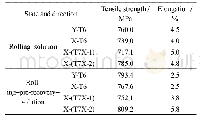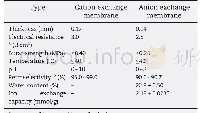《Table 1.Material properties of 1050 aluminum alloy used in the numerical simulation》
 提示:宽带有限、当前游客访问压缩模式
提示:宽带有限、当前游客访问压缩模式
本系列图表出处文件名:随高清版一同展现
《Influence of a multi-step process on the thickness reduction error of sheet metal in a flexible rolling process》
Fig.5 shows the discretized forming roll set model.Numerous individual rigid short rolls make up the forming roll set in a specific arc,and each short roll can rotate around its own axis.In the meshing,eight-node hexahedron elements are used.In the thickness direction,three layers of mesh are used.The sheet metal moves under the friction between the forming roll sets and itself;the friction coefficient is 0.2.The discrete short rolls are defined as rigid bodies.Because analyses of the force and deformation of a forming tool are not necessary,and because the calculation efficiency and convergence of the model need improvement,the forming roll sets are defined as rigid bodies.The sheet metal is defined as a flexible solid.Reduced integration is used in the finite element model.Its precision is lower than that of total integration,so the simulation results with reduced integration have numerical differences.However,the computing time is greatly reduced,resulting in better practicability and sufficient reliability.The constraints of the motion boundary conditions should be imposed on the reference point of each rigid body short roll.In this process,the contour of the forming roll sets is adjusted to the target shape.The upper forming roll set is pressed down to the target position,and the lower flexible roll is fixed.The sheet metal is clamped,and the upper and the lower forming roll sets rotate at the same speed and in opposite directions.The sheet metal moves under the friction.The forming roll sets rotate until the processing is completed.The material used in the numerical simulation in the present work is 1050 aluminum alloy;its properties are shown in Table 1.
| 图表编号 | XD0028409300 严禁用于非法目的 |
|---|---|
| 绘制时间 | 2019.01.01 |
| 作者 | Yi Li、Ming-zhe Li、Kai Liu |
| 绘制单位 | Dieless Forming Technology Center, Roll Forging Institute, Jilin University、College of Materials Science and Engineering, Jilin University、Dieless Forming Technology Center, Roll Forging Institute, Jilin University、College of Materials Science and Enginee |
| 更多格式 | 高清、无水印(增值服务) |





